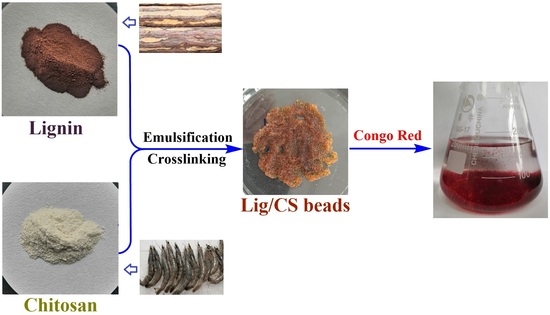Design, Synthesis and Adsorption Evaluation of Bio-Based Lignin/Chitosan Beads for Congo Red Removal
Abstract
:1. Introduction
2. Materials and Methods
2.1. Materials
2.2. Preparation of Bio-Based Lignin/Chitosan (Lig/CS) Beads
2.3. Characterization
2.4. Adsorption Experiments
3. Results
3.1. Synthesis and Characterization of Lig/CS Beads
3.1.1. Morphology Analysis
3.1.2. Composition Analysis
3.1.3. Thermogravimetric Analysis
3.2. Adsorption and Regeneration Behaviour of Lig/CS Beads
3.2.1. Effect of Lignin Content, pH and Temperature
3.2.2. Effect of Concentration and Time
3.2.3. Adsorption Kinetic
3.2.4. Regeneration Behaviour
3.2.5. Comparative Analysis of CR Adsorption
4. Conclusions
Author Contributions
Funding
Institutional Review Board Statement
Informed Consent Statement
Data Availability Statement
Conflicts of Interest
References
- Sala, E.; Mayorga, J.; Bradley, D.; Cabral, R.B.; Atwood, T.B.; Auber, A.; Cheung, W.; Costello, C.; Ferretti, F.; Friedlander, M.A.; et al. Protecting the Global Ocean for Biodiversity, Food and Climate. Nature 2021, 7854, 397–402. [Google Scholar] [CrossRef] [PubMed]
- Sullivan, S.M.P.; Rains, M.C.; Rodemald, A.D.; Buzbee, W.W.; Rosemond, A.D. Distorting Science, Putting Water at Risk. Science 2020, 6505, 766–768. [Google Scholar] [CrossRef]
- Li, Y.; Meas, A.; Shan, S.D.; Yang, R.Q.; Gai, X.K. Production and Optimization of Bamboo Hydrochars for Adsorption of Congo red and 2-Naphthol. Bioresour. Technol. 2016, 207, 379–386. [Google Scholar] [CrossRef]
- Mall, I.D.; Srivastava, V.C.; Agarwal, N.K.; Mishra, I.M. Removal of Congo Red from Aqueous Solution by Bagasse Fly Ash and Activated Carbon: Kinetic study and equilibrium isotherm analyses. Chemosphere 2005, 61, 492–501. [Google Scholar] [CrossRef] [PubMed]
- Srivastava, V.; Zare, E.N.; Makvandi, P.; Zheng, X.-Q.; Iftekhat, S.; Wu, A.; Padil, T.V.V.; Mokhtari, B.; Varma, S.R.; Tay, R.F.; et al. Cytotoxic Aquatic Pollutants and Their Removal by Nanocomposite-based Sorbents. Chemosphere 2020, 258, 127324. [Google Scholar] [CrossRef] [PubMed]
- Zhou, Y.B.; Lu, J.; Zhou, Y.; Liu, Y.D. Recent Advances for Dyes Removal Using Novel Adsorbents: A Review. Environ. Pollut. 2019, 252, 352–3665. [Google Scholar] [CrossRef]
- Kim, J.; Lee, H.; Vo, H.T.; Lee, G.; Kim, N.; Jang, S.; Joo, J.B. Bead-Shaped Mesoporous Alumina Adsorbents for Adsorption of Ammonia. Materials 2020, 13, 1375. [Google Scholar] [CrossRef] [PubMed] [Green Version]
- Wang, Z.L. Effect of Adsorbent Shape on Adsorption Dynamics in A Batch Adsorber. Chem. Eng. Sci. 1999, 54, 5787–5790. [Google Scholar] [CrossRef]
- Hassan, M.M.; Carr, C.M. A Critical Review on Recent Advancements of the Removal of Reactive Dyes from Dyehouse Effluent by Ion-exchange Adsorbents. Chemosphere 2018, 209, 201–219. [Google Scholar] [CrossRef]
- Villarreal, I.A.; Arriagada, D.C.; Mayorga, C.K.; Urbina, K.P.; Valencia, R.M.; Gonzalez, J. Importance of the Interaction Adsorbent-adsorbate in the Dyes Adsorption Process and DFT Modeling. J. Mol. Struct. 2020, 1203, 127398. [Google Scholar] [CrossRef]
- Gu, F.; Geng, J.; Li, M.L.; Chang, J.M.; Cui, Y. Synthesis of Chitosan-Ignosulfonate Composite as an Adsorbent for Dyes and Metal Ions Removal from Wastewater. ACS Omega 2019, 4, 21421–21430. [Google Scholar] [CrossRef] [PubMed] [Green Version]
- Han, X.B.; Gao, J.; Chen, T.; Zhao, Y. Interfacial Interaction and Steric Repulsion in Polymer-assisted Liquid Exfoliation to Produce High-quality Graphene. Chem. Pap. 2020, 74, 757–765. [Google Scholar] [CrossRef]
- Chen, T.; Zhao, Y.; Sang, Y.N.; Tang, M.; Hu, G.W.; Han, X.B.; Gao, J.; Ma, R. Facile synthesis of magnetic CS-g-SPSS microspheres via electron beam radiation for efficient removal of methylene blue. J. Saudi Chem. Soc. 2021, 25, 101299. [Google Scholar] [CrossRef]
- Suginta, W.; Khunkaewla, P.; Schulte, A. Electrochemical Biosensor Applications of Polysaccharides Chitin and Chitosan. Chem. Rev. 2013, 113, 5458–5547. [Google Scholar] [CrossRef]
- Gericke, M.; Trygg, J.; Fardim, P. Functional Cellulose Beads: Preparation, Characterization, and Applications. Chem. Rev. 2013, 113, 4812–4836. [Google Scholar] [CrossRef]
- Ahmad, A.; Mubarak, N.M.; Jannat, F.T.; Ashfaq, T.; Santulli, C.; Rizwan, M.; Najda, A.; Bin-Jumah, M.; Abdel-Daim, M.M.; Hussain, S.; et al. A Critical Review on the Synthesis of Natural Sodium Alginate Based Composite Materials: An Innovative Biological Polymer for Biomedical Delivery Applications. Processes 2021, 9, 137. [Google Scholar] [CrossRef]
- Sun, Z.H.; Fridrich, B.; Santi, A.; Elangovan, S.; Barta, K. Bright Side of Lignin Depolymerization: Toward New Platform Chemicals. Chem. Rev. 2018, 118, 614–678. [Google Scholar] [CrossRef] [PubMed] [Green Version]
- Bacelo, H.A.M.; Santos, S.C.R.; Botelho, C.M.S. Tannin-based Biosorbents for Environmental Applications—A Review. Chem. Eng. Sci. 2016, 303, 575–587. [Google Scholar] [CrossRef]
- Bai, H.J.; Chen, J.H.; Zhou, X.Y.; Hu, C.Z. Single and Binary Adsorption of Dyes from Aqueous Solutions Using Functionalized Microcrystalline Cellulose from Cotton Fiber. Korean J. Chem. Eng. 2020, 37, 1926–1932. [Google Scholar] [CrossRef]
- Du, Q.J.; Li, Y.H.; Li, J.B.; Zhang, Z.; Qiao, B.; Sui, K.; Wang, D.; Wang, C.; Li, H.; Xia, Y. Preparation of Graphene Oxide/Chitosan Pellets and Their Adsorption Properties for Congo Red. Int. J. Nanosci. 2019, 18, 1850030. [Google Scholar] [CrossRef] [Green Version]
- Li, W.; Mu, B.N.; Yang, Y.Q. Feasibility of Industrial-scale Treatment of Dye Wastewater via Bioadsorption Technology. Bioresour. Technol. 2019, 277, 157–170. [Google Scholar] [CrossRef] [PubMed]
- Tamjidi, S.; Ameri, A. A Review of the Application of Sea Material Shells as Low Cost and Effective Bio-adsorbent for Removal of Heavy Metals from Wastewater. Environ. Sci. Pollut. R 2022, 27, 31105–31119. [Google Scholar] [CrossRef] [PubMed]
- Wawrzkiewica, M.; Bartczak, P.; Jesionowski, T. Enhanced Removal of Hazardous Dye form Aqueous Solutions and Real Textile Wastewater Using Bifunctional Chitin/lignin Biosorbent. Int. J. Biol. Macromol. 2017, 99, 754–764. [Google Scholar] [CrossRef] [PubMed]
- Bartczak, P.; Klapiszewski, L.; Wysokowski, M.; Majchrzak, I.; Czernika, W.; Piasecki, A.; Ehrlich, H.; Jesionowski, T. Treatment of Model Solutions and Wastewater Containing Selected Hazardous Metal Ions Using A Chitin/lignin Hybrid Material as An Effective Sorbent. J. Environ. Manag. 2017, 204, 300–310. [Google Scholar] [CrossRef]
- Wysokowski, M.; Klapiszewski, L.; Moszynski, D.; Bartczak, P.; Szatkowski, T.; Majchrzak, I.; Stefanska, K.S.; Bazhenov, V.; Jesionowski, T. Modification of Chitin with Kraft Lignin and Development of New Biosorbents for Removal of Cadmium(II) and Nickel(II) Ions. Mar. Drugs 2014, 12, 2245–2268. [Google Scholar] [CrossRef] [PubMed] [Green Version]
- Zdarta, J.; Klapiszewski, L.; Wysokowski, M.; Norman, M.; Radzimska, A.K.; Moszynski, D.; Ehrlich, H.; Maciejewski, H.; Stelling, A.L.; Jesionowski, T. Chitin-Lignin Material as a Novel Matrix for Enzyme Immobilization. Mar. Drugs 2015, 13, 2424–2446. [Google Scholar] [CrossRef] [PubMed] [Green Version]
- Duan, Y.Q.; Freyburger, A.; Kunz, W.; Zollfrank, C. Lignin/Chitin Films and Their Adsorption Characteristics for Heavy Metal Ions. ACS Sustain. Chem. Eng. 2018, 6, 6965–6973. [Google Scholar] [CrossRef]
- Zhou, Z.K.; Lin, S.Q.; Yue, T.L.; Lee, T.C. Adsorption of Food Dyes from Aqueous Solution by Glutaraldehyde Cross-linked Magnetic Chitosan Nanoparticles. J. Food Eng. 2014, 126, 133–141. [Google Scholar] [CrossRef]
- Nagireddi, S.; Katiyar, V.; Uppaluri, R. Pd(II) Adsorption Characteristics of Glutaraldehyde Cross-linked Chitosan Copolymer Resin. Int. J. Biol. Macromol. 2017, 94, 72–84. [Google Scholar] [CrossRef] [PubMed]
- Yang, W.J.; Qi, G.C.; Kenny, J.M.; Puglia, D.; Ma, P.M. Effect of Cellulose Nanocrystals and Lignin Nanoparticles on Mechanical, Antioxidant and Water Vapour Barrier Properties of Glutaraldehyde Crosslinked PVA Films. Polymers 2020, 12, 1364. [Google Scholar] [CrossRef]
- Zhang, Q.X.; Zhang, Z.P.; Li, A.M.; Pan, B.C.; Zhang, X.L. Advance in Ion Exchange and Adsorption Resins in China. Acta Polym. Sin. 2018, 7, 814–828. [Google Scholar] [CrossRef]
- Ma, M.S.; Liu, Z.; Hui, L.F.; Shang, Z.; Yuan, S.Y.; Dai, L.; Liu, P.T.; Liu, X.L.; Ni, Y.H. Lignin-containing Cellulose Nanocrystals/Sodium Alginate Beads as Highly Effective Adsorbents for Cationic Organic Dyes. Int. J. Biol. Macromol. 2019, 139, 640–646. [Google Scholar] [CrossRef] [PubMed]
- Wu, M.; Chen, W.J.; Mao, Q.H.; Bai, Y.S.; Ma, H.Z. Facile Synthesis of Chitosan/gelatin Filled with Graphene Bead Adsorbent for Orange II Removal. Chem. Eng. Res. Des. 2019, 144, 35–46. [Google Scholar] [CrossRef]
- Bui, T.H.; Lee, W.; Jeon, S.B.; Kim, K.W.; Lee, Y. Enhanced Gold(III) Adsorption Using Glutaraldehyde-crosslinked Chitosan Beads: Effect of Crosslinking Degree on Adsorption Selectivity, Capacity, and Mechanism. Sep. Purif. Technol. 2020, 248, 116989. [Google Scholar] [CrossRef]
- Zhang, C.L.; Chen, Z.Z.; Guo, W.; Zhu, C.W.; Zou, Y.J. Simple Fabrication of Chitosan/Graphene Nanoplates Composite Spheres for Efficient Adsorption of Acid Dyes from Aqueous Solution. Int. J. Biol. Macromol. 2018, 112, 1048–1054. [Google Scholar] [CrossRef] [PubMed]
- Senthilkumaar, S.; Kalaamani, P.; Subburaam, C.V. Liquid Phase Adsorption of Crystal Violet onto Activated Carbons derived from Male Flowers of Coconut Tree. J. Hazard. Mater. 2006, 136, 800–808. [Google Scholar] [CrossRef] [PubMed]
- Ofomaja, A.E.; Ho, Y.S. Equilibrium Sorption of Anionic Dye from Aqueous Solution by Palm Kernel Fibre as Sorbent. Dye Pigment. 2007, 74, 60–66. [Google Scholar] [CrossRef]
- Zhang, L.J.; Zhao, D.Q.; Lu, Y.; Chen, J.H.; Li, H.T.; Xie, J.H.; Xu, Y.; Yuan, H.K.; Liu, X.J.; Zhu, X.Y.; et al. A Graphene Oxide Modified Cellulose Nanocrystal/PNIPAAm IPN Hydrogel for the Adsorption of Congo Red and Methylene Blue. New J. Chem. 2021, 45, 16679–16688. [Google Scholar] [CrossRef]
- Zhu, H.Y.; Fu, Y.Q.; Jiang, R.; Jiang, J.H.; Xiao, L.; Zeng, G.M.; Zhao, S.L.; Wang, Y. Adsorption Removal of Congo Red onto Magnetic Cellulose/Fe3O4/Activated Carbon Composite: Equilibrium, Kinetic and Thermodynamic Studies. Chem. Eng. J. 2011, 173, 494–502. [Google Scholar] [CrossRef]
- Chen, T.; Yan, C.J.; Wang, Y.; Tang, C.; Zhou, S.; Zhao, Y.; Ma, R.; Duan, P. Synthesis of Activated Carbon-based Amino Phosphonic Acid Chelating Resin and Its Adsorption Properties for Ce(III) Removal. Environ. Technol. 2015, 36, 2168. [Google Scholar] [CrossRef]
- Wu, Z.L.; Liu, F.; Li, C.K.; Chen, X.Q.; Yu, J.G. A Sandwich-structured Graphene-based Composite: Preparation, Characterization, and its Adsorption Behaviors for Congo Red. Colloid Surf. A Physicochem. Eng. Asp. 2016, 509, 65–72. [Google Scholar] [CrossRef]
- Mohamed, N.A.; Harby, N.F.; Almaeshed, M.S. Enhancement of Adsorption of Congo Red Dye onto Novel Antimicrobial Trimellitic Anhydride Isothiocyanate-cross-linked Chitosan Hydrogels. Polym. Bull. 2020, 77, 6135–6160. [Google Scholar] [CrossRef]
- Kim, U.J.; Kim, D.; You, J.; Choi, J.W.; Kimura, S.; Wada, M. Preparation of Cellulose-chitosan Foams Using an Aqueous Lithium Bromide Solution and Their Adsorption Ability for Congo Red. Cellulose 2018, 25, 2615–2628. [Google Scholar] [CrossRef]
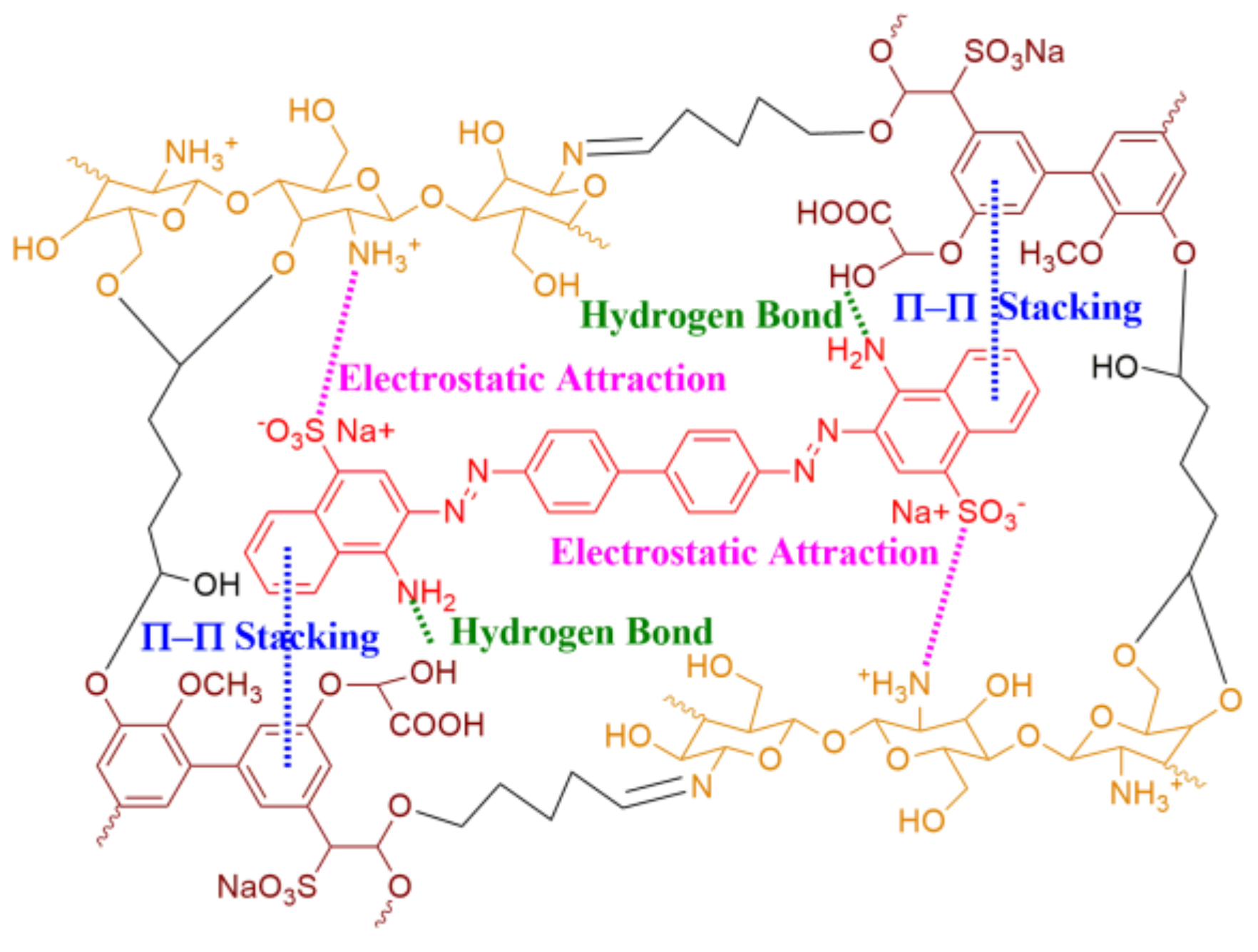

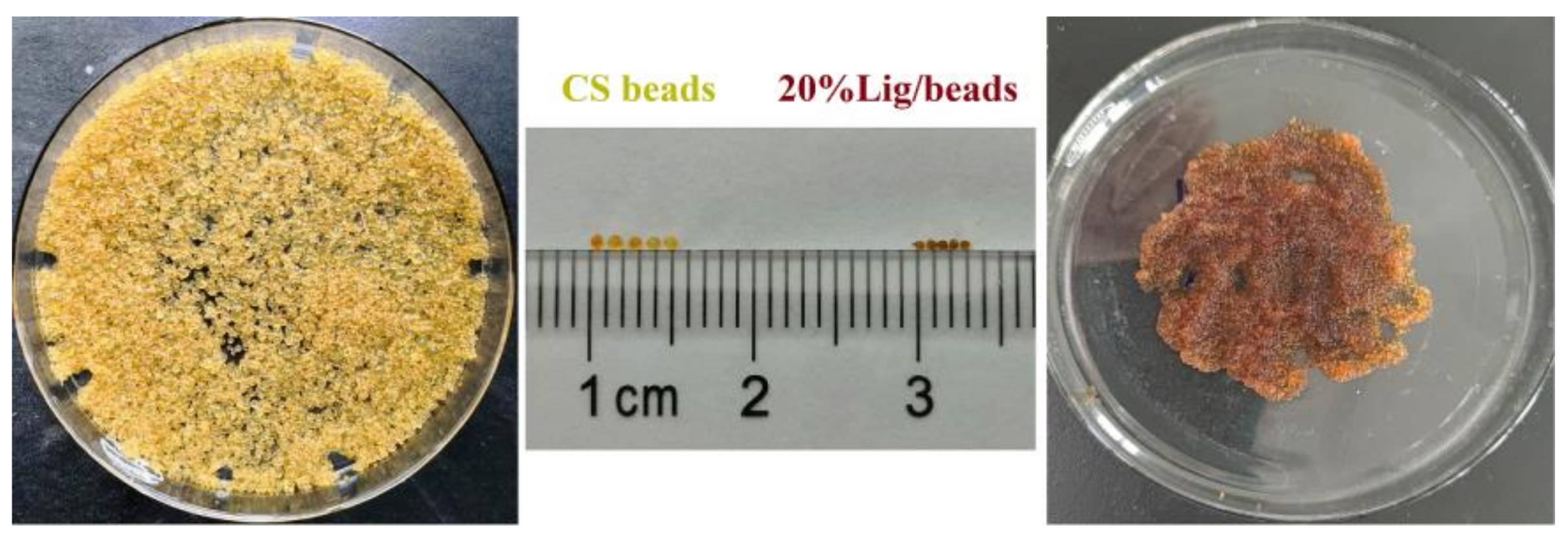
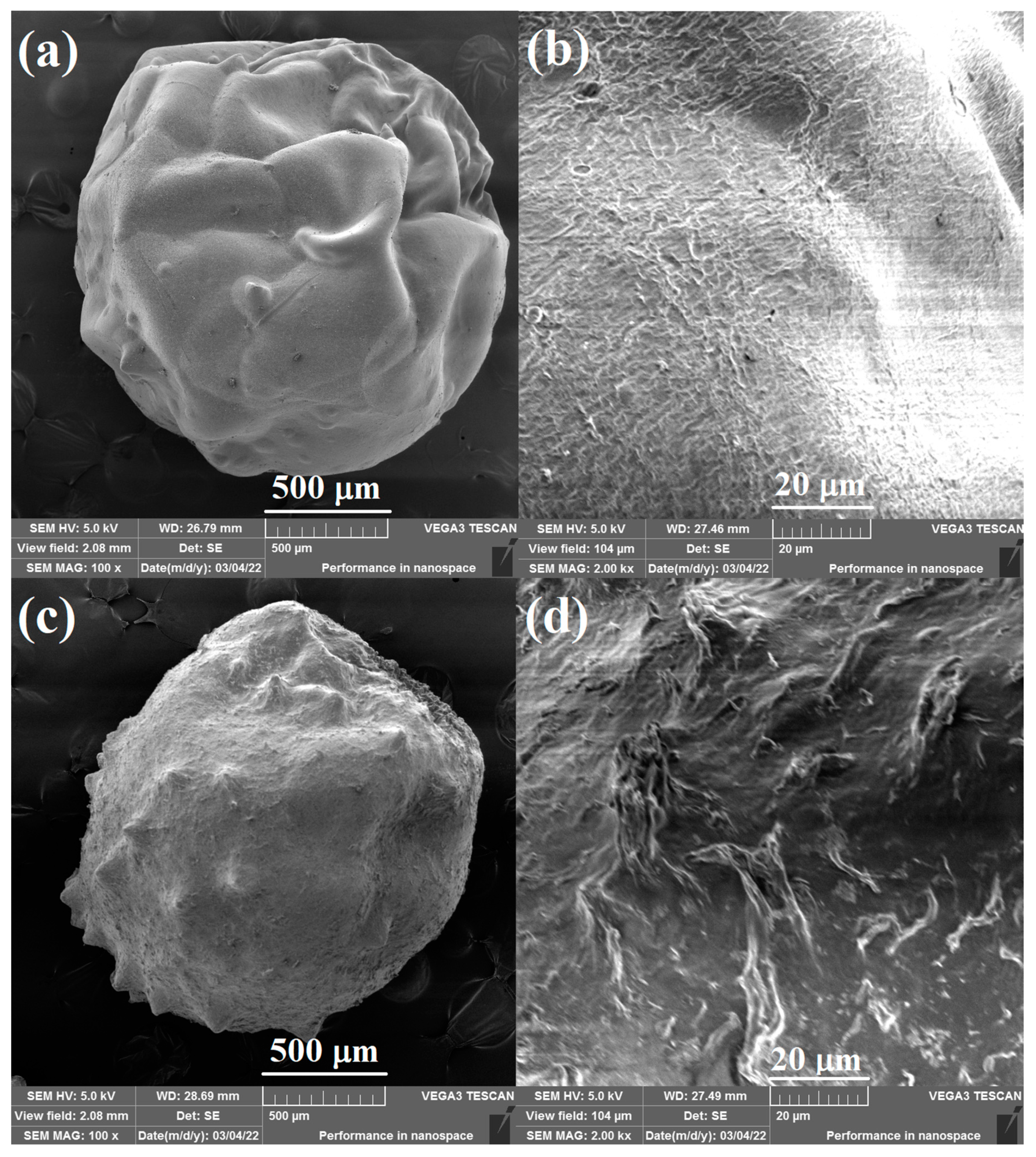



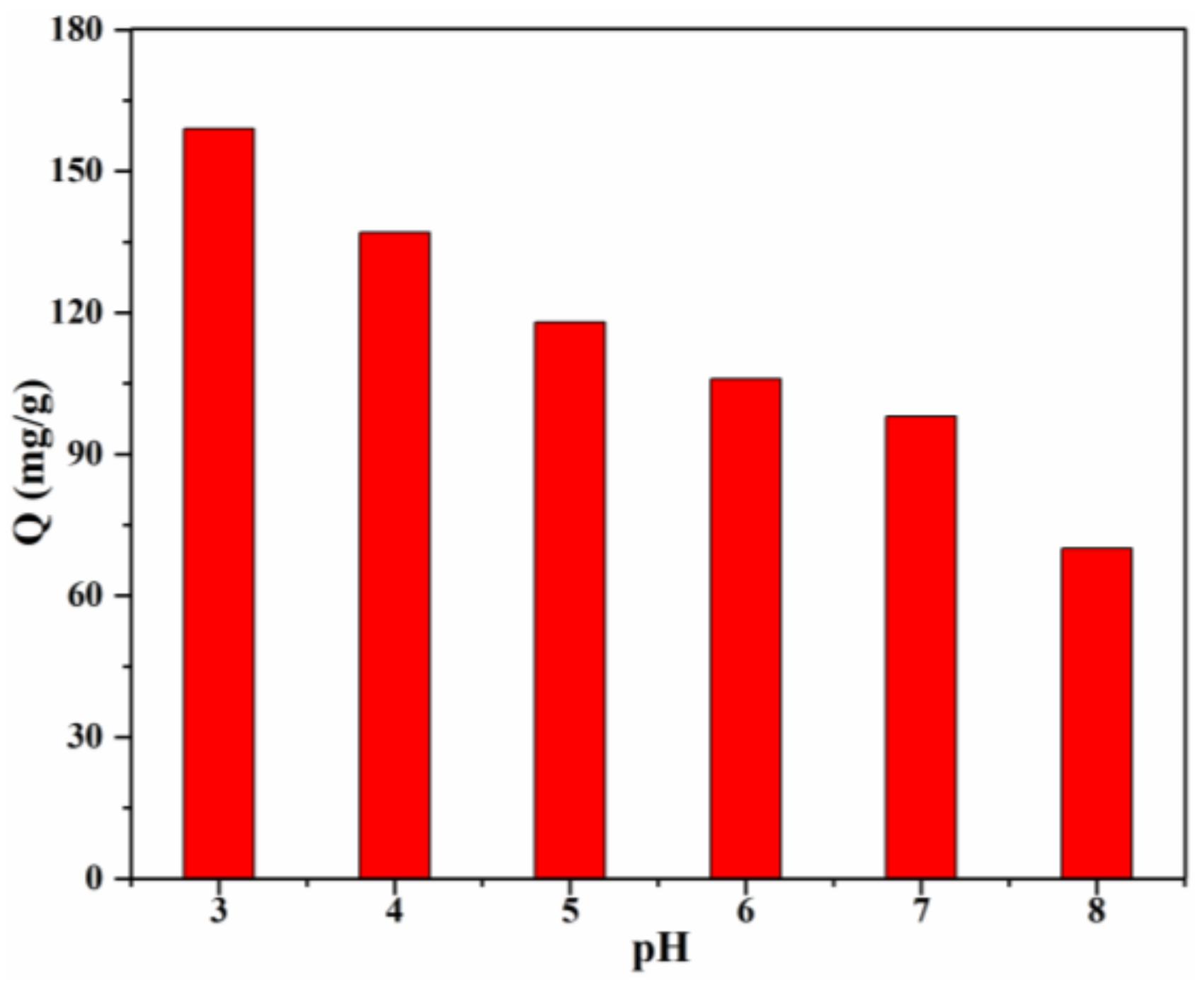

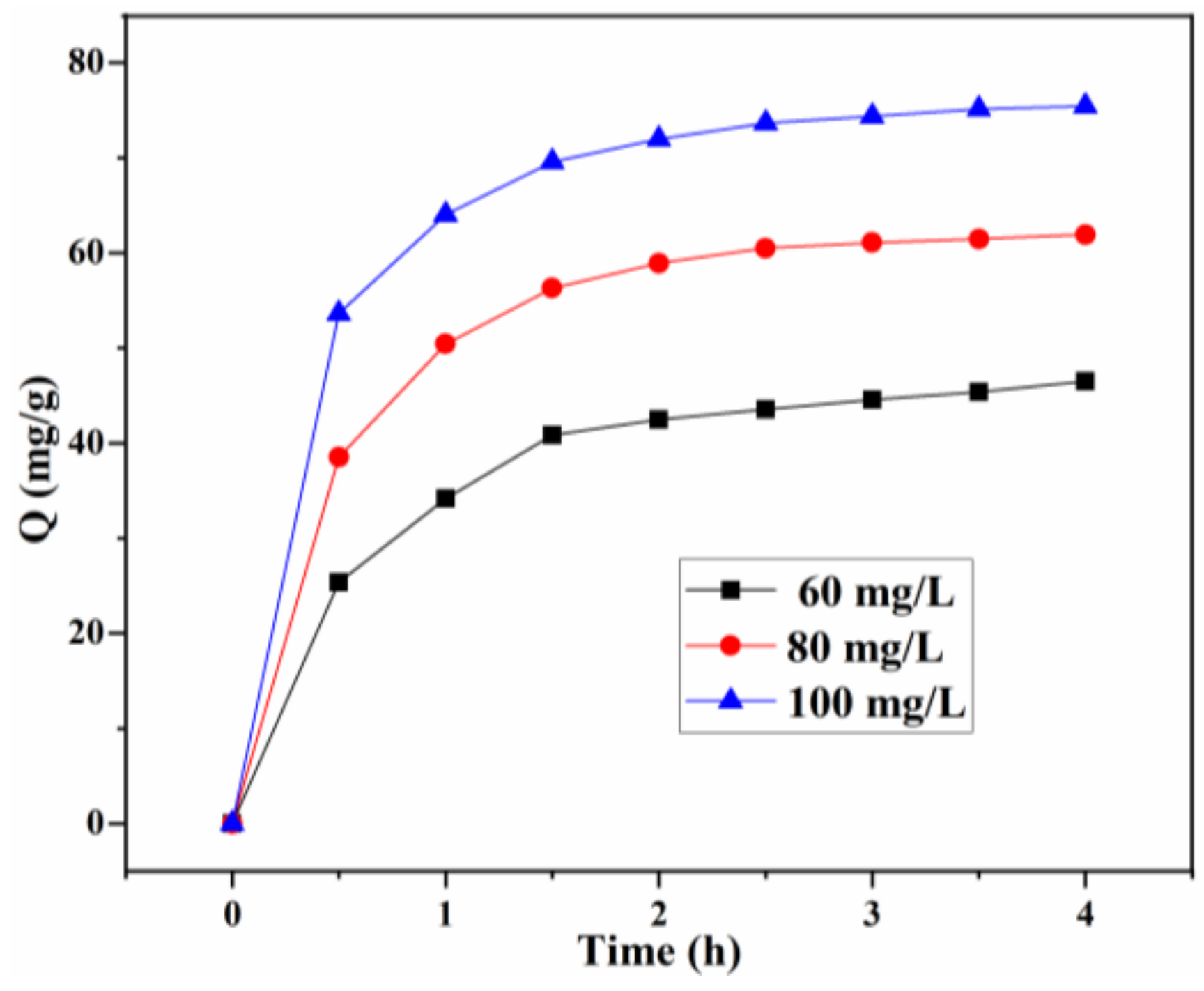
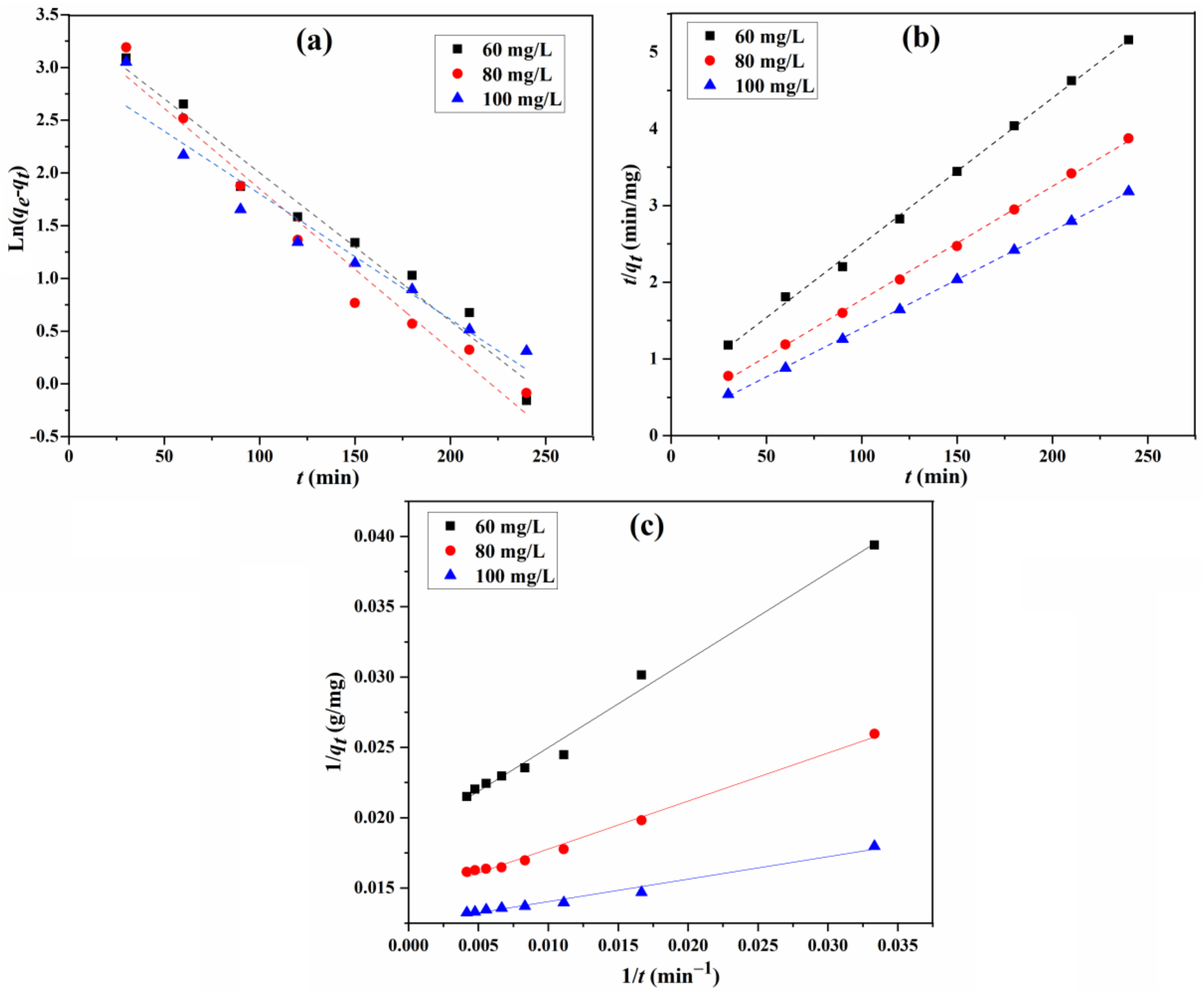
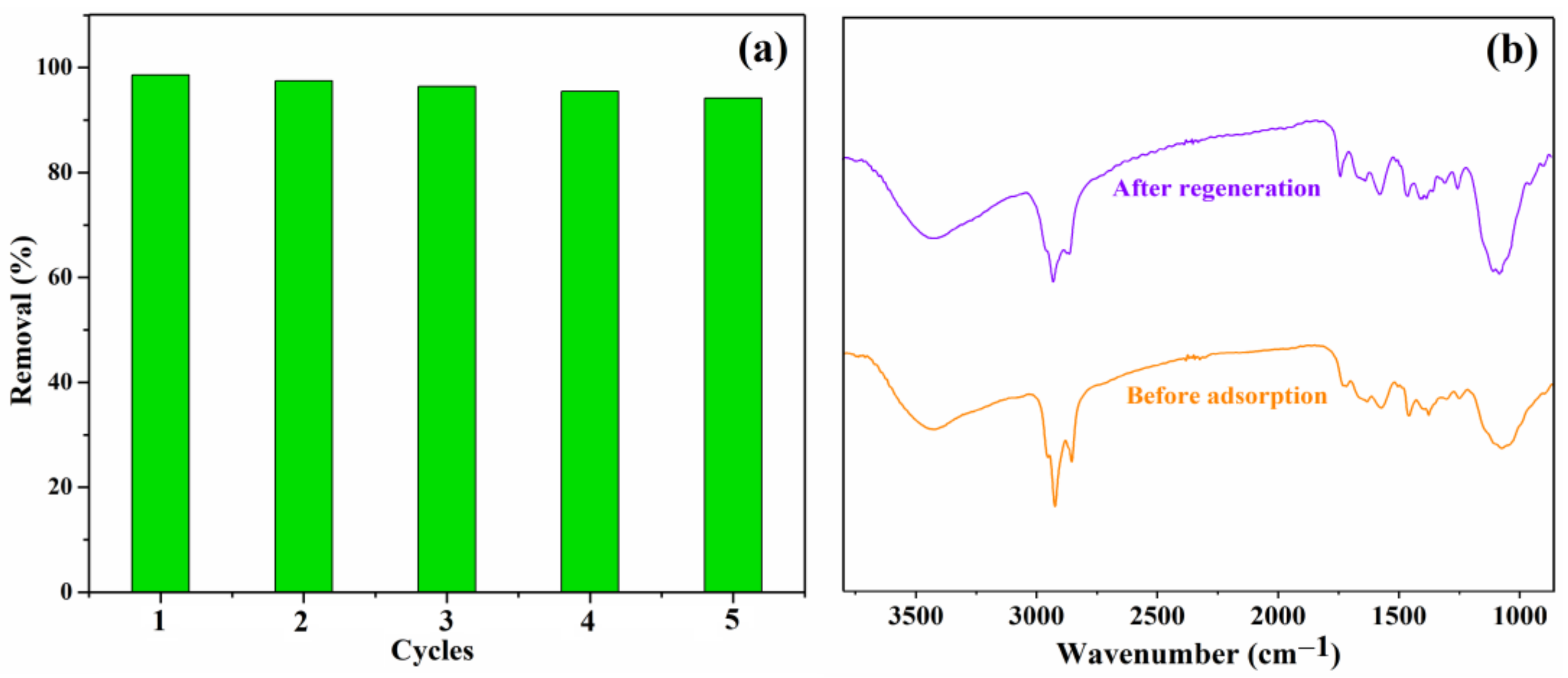
| Temperature (K) | ln K0 | ΔG0 (kJ/mol) | ΔH0 (kJ/mol) | ΔS0 (kJ/mol·K) |
|---|---|---|---|---|
| 288 | 0.53 | −1.31 | 8.84 | −0.169 |
| 298 | 1.36 | −3.37 | - | - |
| 308 | 1.86 | −4.61 | - | - |
| Kinetics Models | Pseudo-First-Order | Type 1 Pseudo-Second-Order | Type 2 Pseudo-Second-Order |
|---|---|---|---|
| Equations | |||
| Rate constant k | −slope | slope2/intercept | intercept2/slope |
| qe,cal | eintercept | 1/slope | 1/intercept |
| Adsorption Isotherm Models | Coefficients | 60 mg/L | 80 mg/L | 100 mg/L |
|---|---|---|---|---|
| Pseudo-first-order | qe,cal (mg/g) | 34.9878 | 34.7092 | 23.8645 |
| k1 (L/g) | 0.0141 | 0.0152 | 0.0118 | |
| R2 | 0.9666 | 0.9622 | 0.9298 | |
| Type 1 pseudo-second-order | qe,cal (mg/g) | 52.5486 | 69.9301 | 78.8643 |
| k2 (×10−3) (g/mg min) | 0.6161 | 0.7519 | 1.206 | |
| R2 | 0.9982 | 0.9991 | 0.9998 | |
| Type 2 pseudo-second-order | qe,cal (mg/g) | 53.2765 | 69.6378 | 80.3858 |
| K3 (g/mg min) | 20.5946 | 8.1166 | 2.0451 | |
| R2 | 0.9874 | 0.9917 | 0.9783 |
| Adsorbent | C0 (mg/L) | Qmax (mg/g) | Removal (%) | Regeneration | Morphology | Ref. |
|---|---|---|---|---|---|---|
| Lignin/Chitosan | 200 | 173 | 86.5 | >90% 5 cycles | millimeter-sized bead | This work |
| Chitosan-Ignosulfonate | 1000 | 450 | 45.0 | ND | powder | [11] |
| GO/Chitosan | 50 | 125 | 84.6 | ND | pellets | [20] |
| GO/Cellulose/PNIPAAm | 800 | 695 | 43.4 | 84.9 | hydrogel | [38] |
| PPD-GO | 800 | 893 | 27.9 | ND | powder | [41] |
| Modified Chitosan | 696 | 63 | 96.6 | 100% 3 cycles | hydrogel | [42] |
| Cellulose-chitosan | 4000 | 1170 | 58.5 | hard | foams | [43] |
Publisher’s Note: MDPI stays neutral with regard to jurisdictional claims in published maps and institutional affiliations. |
© 2022 by the authors. Licensee MDPI, Basel, Switzerland. This article is an open access article distributed under the terms and conditions of the Creative Commons Attribution (CC BY) license (https://creativecommons.org/licenses/by/4.0/).
Share and Cite
Han, X.; Li, R.; Miao, P.; Gao, J.; Hu, G.; Zhao, Y.; Chen, T. Design, Synthesis and Adsorption Evaluation of Bio-Based Lignin/Chitosan Beads for Congo Red Removal. Materials 2022, 15, 2310. https://doi.org/10.3390/ma15062310
Han X, Li R, Miao P, Gao J, Hu G, Zhao Y, Chen T. Design, Synthesis and Adsorption Evaluation of Bio-Based Lignin/Chitosan Beads for Congo Red Removal. Materials. 2022; 15(6):2310. https://doi.org/10.3390/ma15062310
Chicago/Turabian StyleHan, Xiaobing, Rong Li, Pengpai Miao, Jie Gao, Guowen Hu, Yuan Zhao, and Tao Chen. 2022. "Design, Synthesis and Adsorption Evaluation of Bio-Based Lignin/Chitosan Beads for Congo Red Removal" Materials 15, no. 6: 2310. https://doi.org/10.3390/ma15062310





